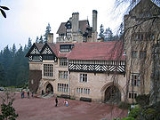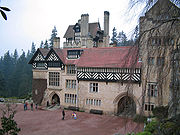
Cragside
Encyclopedia
Cragside is a country house in the civil parish of Cartington
in Northumberland
, England
. It was the first house in the world to be lit using hydroelectric
power. Built into a rocky hillside above a 4 km² forest garden, it was the country home of Lord Armstrong
and has been in the care of the National Trust
since 1977.
Cragside, named after Cragend Hill above the house, was built in 1863 as a modest two-storey country lodge, but was subsequently extended to designs by Norman Shaw, transforming it into an elaborate mansion in the Free Tudor style. At one point, the building included an astronomical observatory
and a scientific laboratory.
 In 1868, a hydraulic engine was installed, with water being used to power labour-saving machines such as laundry equipment, a rotisserie
In 1868, a hydraulic engine was installed, with water being used to power labour-saving machines such as laundry equipment, a rotisserie
and a hydraulic lift
. In 1870, water from one of the estate's lakes was used to drive a Siemens
dynamo
in what was the world's first hydroelectric power station
. The resultant electricity was used to power an arc lamp
installed in the Gallery in 1878. The arc lamp was replaced in 1880 by Joseph Swan
's incandescent lamps in what Swan considered 'the first proper installation' of electric lighting.
The generators, which also provided power for the farm buildings on the estate, were constantly extended and improved to match the increasing electrical demand in the house.
The Grade I listed house is surrounded by one of Europe
's largest rock garden
s, a large number of rhododendron
s and a large collection of mostly coniferous tree
s.
The documentary series Abroad Again in Britain by Jonathan Meades
focused on Cragside in episode 2 (2005).
In 2007, Cragside reopened after undergoing "total refurbishment."
Cragside was featured during the 21 August 2011 episode of BBC One's
Britain's Hidden Heritage programme.
Cartington
Cartington is a village and civil parish in Northumberland, England. It is about south west of Alnwick, and about north west of Rothbury, and has a population of 97....
in Northumberland
Northumberland
Northumberland is the northernmost ceremonial county and a unitary district in North East England. For Eurostat purposes Northumberland is a NUTS 3 region and is one of three boroughs or unitary districts that comprise the "Northumberland and Tyne and Wear" NUTS 2 region...
, England
England
England is a country that is part of the United Kingdom. It shares land borders with Scotland to the north and Wales to the west; the Irish Sea is to the north west, the Celtic Sea to the south west, with the North Sea to the east and the English Channel to the south separating it from continental...
. It was the first house in the world to be lit using hydroelectric
Hydroelectricity
Hydroelectricity is the term referring to electricity generated by hydropower; the production of electrical power through the use of the gravitational force of falling or flowing water. It is the most widely used form of renewable energy...
power. Built into a rocky hillside above a 4 km² forest garden, it was the country home of Lord Armstrong
William George Armstrong, 1st Baron Armstrong
William George Armstrong, 1st Baron Armstrong CB, FRS was an effective Tyneside industrialist who founded the Armstrong Whitworth manufacturing empire.-Early life:...
and has been in the care of the National Trust
National Trust for Places of Historic Interest or Natural Beauty
The National Trust for Places of Historic Interest or Natural Beauty, usually known as the National Trust, is a conservation organisation in England, Wales and Northern Ireland...
since 1977.
Cragside, named after Cragend Hill above the house, was built in 1863 as a modest two-storey country lodge, but was subsequently extended to designs by Norman Shaw, transforming it into an elaborate mansion in the Free Tudor style. At one point, the building included an astronomical observatory
Observatory
An observatory is a location used for observing terrestrial or celestial events. Astronomy, climatology/meteorology, geology, oceanography and volcanology are examples of disciplines for which observatories have been constructed...
and a scientific laboratory.

Rotisserie
Rotisserie is a style of roasting where meat is skewered on a spit - a long solid rod used to hold food while it is being cooked over a fire in a fireplace or over a campfire, or roasted in an oven. This method is generally used for cooking large joints of meat or entire animals, such as pigs,...
and a hydraulic lift
Elevator
An elevator is a type of vertical transport equipment that efficiently moves people or goods between floors of a building, vessel or other structures...
. In 1870, water from one of the estate's lakes was used to drive a Siemens
Siemens AG
Siemens AG is a German multinational conglomerate company headquartered in Munich, Germany. It is the largest Europe-based electronics and electrical engineering company....
dynamo
Dynamo
- Engineering :* Dynamo, a magnetic device originally used as an electric generator* Dynamo theory, a theory relating to magnetic fields of celestial bodies* Solar dynamo, the physical process that generates the Sun's magnetic field- Software :...
in what was the world's first hydroelectric power station
Power station
A power station is an industrial facility for the generation of electric energy....
. The resultant electricity was used to power an arc lamp
Arc lamp
"Arc lamp" or "arc light" is the general term for a class of lamps that produce light by an electric arc . The lamp consists of two electrodes, first made from carbon but typically made today of tungsten, which are separated by a gas...
installed in the Gallery in 1878. The arc lamp was replaced in 1880 by Joseph Swan
Joseph Swan
Sir Joseph Wilson Swan was a British physicist and chemist, most famous for the invention of the incandescent light bulb for which he received the first patent in 1878...
's incandescent lamps in what Swan considered 'the first proper installation' of electric lighting.
The generators, which also provided power for the farm buildings on the estate, were constantly extended and improved to match the increasing electrical demand in the house.
The Grade I listed house is surrounded by one of Europe
Europe
Europe is, by convention, one of the world's seven continents. Comprising the westernmost peninsula of Eurasia, Europe is generally 'divided' from Asia to its east by the watershed divides of the Ural and Caucasus Mountains, the Ural River, the Caspian and Black Seas, and the waterways connecting...
's largest rock garden
Rock Garden
The Rock Garden or Rock Garden of Chandigarh is a Sculpture garden in Chandigarh, India, also known as Nek Chand's Rock Garden after its founder Nek Chand, a government official who started the garden secretly in his spare time in 1957. Today it is spread over an area of forty-acres , it is...
s, a large number of rhododendron
Rhododendron
Rhododendron is a genus of over 1 000 species of woody plants in the heath family, most with showy flowers...
s and a large collection of mostly coniferous tree
Tree
A tree is a perennial woody plant. It is most often defined as a woody plant that has many secondary branches supported clear of the ground on a single main stem or trunk with clear apical dominance. A minimum height specification at maturity is cited by some authors, varying from 3 m to...
s.
The documentary series Abroad Again in Britain by Jonathan Meades
Jonathan Meades
Jonathan Turner Meades is a British writer on food, architecture, and culture, as well as an author and broadcaster. He is an Honorary Associate of the National Secular Society and a Distinguished Supporter of the British Humanist Association.-Education:Meades was born in Salisbury Wiltshire, and...
focused on Cragside in episode 2 (2005).
In 2007, Cragside reopened after undergoing "total refurbishment."
Cragside was featured during the 21 August 2011 episode of BBC One's
BBC One
BBC One is the flagship television channel of the British Broadcasting Corporation in the United Kingdom. It was launched on 2 November 1936 as the BBC Television Service, and was the world's first regular television service with a high level of image resolution...
Britain's Hidden Heritage programme.

